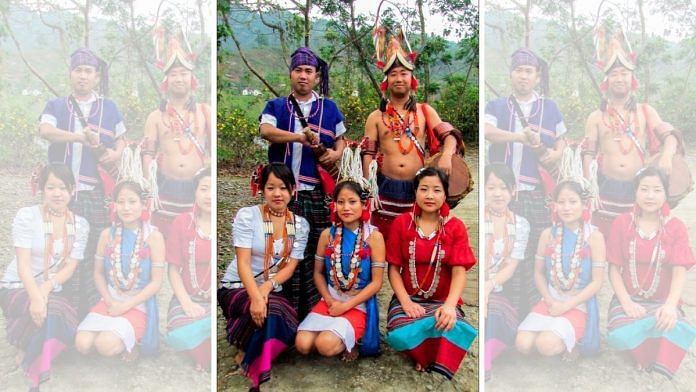New Delhi: For the past several months, Wanglung Mossang, a farmer from Neotan village in Arunachal Pradesh’s Changlang district, has been holding evening classes for a group of college students and some graduates. Wanglung and his motley group are on a mission — to learn and develop a common Tangsa script.
The Tangsa tribe of Arunachal Pradesh is the largest group in the state’s Changlang district and has over 40 sub-tribes, each with its own dialect. But the Tangsa language is still marked as ‘endangered’.
“There are so many dialects spoken in Arunachal Pradesh. The Tangsa tribe alone has more than 40 sub-tribes with each having its own dialect, and without a written form. All of them use Roman script,” the 55-year-old farmer told EastMojo.
A common script for the Tangsa tribe was initially developed in 1990 by a native, Lakhum Mossang. Following Lakhum’s death in 2020, Wanglung decided to take his work forward.
“Initially, the script was meant only for the Mossang sub-tribe. However, in a historical meeting attended by all the sub-tribes of Tangsa in November 2019, the script was unanimously accepted and declared as the common Tangsa script,” Wanglung added.
The new Tangsa script has 48 vowels and 31 consonants, and it has also been approved for inclusion in the Unicode, a global encoding standard. A mobile app has also been developed in the state to help the youth learn this new script.
Also read: Naga couple set to trek to Everest Base Camp to raise funds for orphanage library
Engineer helps kids in Nagaland realise ‘robotics dream’
Kikrukhrielie Khezhie, a mechanical engineer from Nagaland, has been helping students learn robotics through a first-of-its-kind institute in the state called NAGABOTS. Situated in Kohima, Khezhie’s institute offers basic courses as well as advanced Python programming. Classes in the institute began earlier this year.
The idea for starting NAGABOTS arose when Khezhie observed that many people in the state had come up with innovative ideas during the lockdown last year but they acquired those skills from YouTube and other sources on the internet, not via formal education.
He told the Eastern Mirror that even though people were interested, they didn’t know where to start learning robotics.
“Coding has become an integral part of our life, even robotics, machine learning, artificial intelligence … so we feel that at least among the youth, the basic concepts should be ready for all so that we know what is behind,” he was quoted as saying.
Khezhie said his teaching approach was “practical-based and focuses more on projects like developing games, storyboards or animations”. Some of his students have already learnt to develop their own apps.
Catfish species found in Arunachal named after forest officer
A new catfish species discovered in Arunachal Pradesh has been named after the range forest officer of Mouling National Park, S. Rupir Boli, for his help in collecting the specimens during the first survey by researchers.
The species has been named Glyptothorax rupiri and it was collected from the Siang river by a team of researchers, including Laishram Kosygin, Pratima Singh and Shibananda Rathi, from the Zoological Survey of India, Kolkata.
A new sisorid catfish identified as Glyptothorax rupiri, has been named after S. Rupir Boli, a range forest officer of Mouling National Park in Arunachal Pradesh, for his help in collecting the specimens during the first survey by researchers. pic.twitter.com/IJeK3rpSOq
— MyGov Arunachal Pradesh (@MyGovArunachal) August 23, 2021
“It differs from its congeners in the Indian subcontinent by a combination of characters such as the presence of plicae on the ventral surface of the pectoral spine and first pelvic-fin ray and a posteriorly serrated dorsal-fin spine,” the researchers wrote in a paper published in the journal Zootaxa.
They also wrote that the new species is currently “known only from the Jambung stream”, a tributary of the Siang.
62-year-old Manipur woman is the rare cobbler you meet
A woman named Khawlzaning from Pearsonmum village in Manipur’s Churachandpur district has been breaking stereotypes, earning her living as a cobbler for more than two decades. The 62-year-old took to the profession after her husband, who was a cobbler, died in 1997.
Khawlzaning told the Imphal Free Press how when she started out, many, including some of her relatives, found it “strange to see a lady cobbler”, especially one from the “tribal community”.
“My daughters have been very supportive of my work. They are not ashamed of my profession because they know it is a means of livelihood. Besides, I am following the footsteps of their father,” she was quoted as saying.
Some of Khawlzaning’s loyal customers have been coming to her for nearly a decade. “My customers still come to my shop. Some go to the extent of visiting me in my house when I close the shop. I believe it is because people love me and my work,” she added.
Khawlzaning earns about Rs 500-Rs 1,000 a day, enough to support her family.
(Edited by Manasa Mohan)
Also read: This Manipur artist is building a ‘tattoo village’ to revive Nagaland’s dying art



